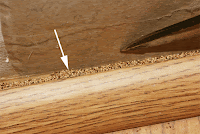 On December 11 I had the privilege once again to participate as an instructor in the 5th Associate Certified Entomologist (ACE) prep class offered in Texas. As with previous classes, the course was sponsored by the Texas Pest Control Association and taught by myself and Dr. Bob Davis of BASF Specialty Products. This class was also co-taught with first-time lecturer Dr. Grady Glenn, pesticide applicator training specialist with Texas AgriLife Extension Service.
On December 11 I had the privilege once again to participate as an instructor in the 5th Associate Certified Entomologist (ACE) prep class offered in Texas. As with previous classes, the course was sponsored by the Texas Pest Control Association and taught by myself and Dr. Bob Davis of BASF Specialty Products. This class was also co-taught with first-time lecturer Dr. Grady Glenn, pesticide applicator training specialist with Texas AgriLife Extension Service.As any of the participants will tell you, this is a classic cram course. We cover topics ranging from a brief introduction to entomology and insect classification, to toxicology, laws and regulations and overviews of cockroach, WDI and rodent biology to just name a few. The pace is quick, but fun as the class interacts with instructors and gets a few pointers about test-taking.
The purpose of the class is to prepare participants to take the challenging ACE exam, one of the prerequisites for becoming an Associate Certified Entomologist. At the end of about 6 hours of cramming we offer the exam to anyone who has applied through ESA and registered to take the test that day.
I enjoy teaching this class because of the quality and enthusiasm of the participants, each of whom must have seven years of experience in the pest control business. The other thing I value, and I think participants do too, is the opportunity we have to review fundamentals--the whys behind many of the little rules and facts we learn in pest control. It's a chance to dig a little deeper than the typical CEU class, and much deeper than technician training.
Of course taking the class is no guarantee of passing the test. Our pass rate is typically 50-60%, though this class had a nearly 90% passing rate. We find that success is highest for those who review the study subjects prior to taking the class and exam. But most importantly, we find that the pass rate is 100% higher for those who take the test than those who think about it but never get around to signing up.
If you've thought about certification, but hesitate at the thought of taking a tough exam (it's been a long time for all of us since our last final exam), consider taking one of the ACE prep courses being offered around the state. The next class and exam will be offered at the B&G Chemical and Equipment Company workshop in Arlingtion, on January 22. Note that the Arlington venue is the only B&G venue that will be offering ACE prep training this year.
To learn more about the ACE or BCE certification programs, check out the Entomological Society of America's website at http://entsoc.org/certification. There are no official study guides, but the website offers a very detailed list of the subject matter that is covered by the exam. Two of the best study resources I recommend include the Truman's Scientific Guide to Pest Management, and the NPMA Field Guide to Structural Pests. I suggest focusing study time on topics you feel a little weak in. Stored product pests and pesticide classification are two subject areas where many applicants seem to struggle. Also, definitely take the sample exam on the ESA website. It gives you an authentic taste of what the real exam is like.
Successful candidates receive a certificate and uniform patch and earn the right to advertise themselves as Associate Certified Entomologists. In addition, ACEs receive the ESA Newsletter and have the option to register for ESA journals and meetings at discounted rates.
Congratulations to those of you who recently took and passed the exam. I look forward to seeing many more of you join the ACE ranks in the near future.



